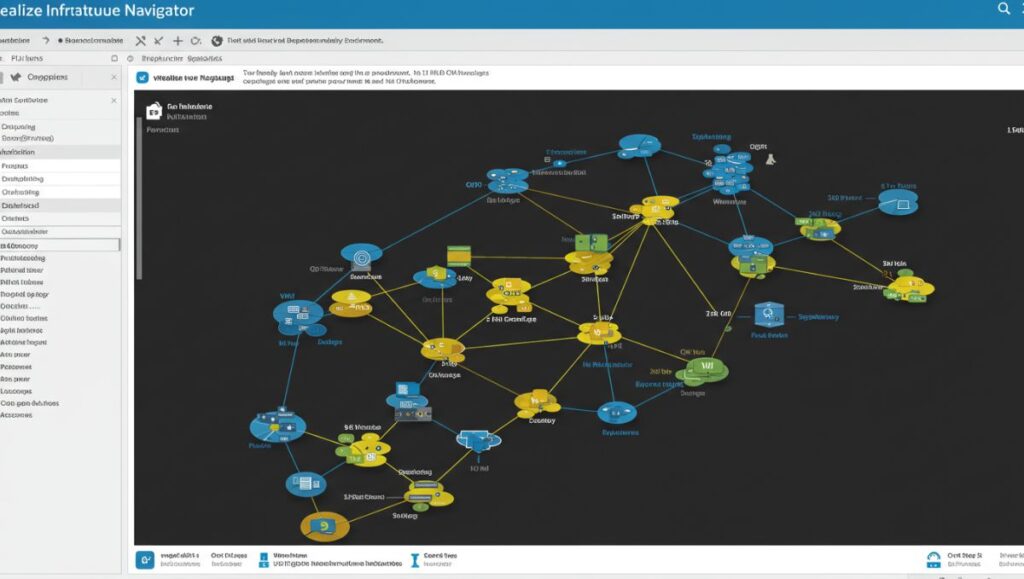In the modern IT world, organizations rely heavily on virtualization to run critical business applications. As virtual infrastructures grow in complexity, managing dependencies, relationships, and performance across hundreds of virtual machines becomes a major challenge.
This is where VMware vRealize Infrastructure Navigator (vRIN) comes in. Designed to work within the vRealize Suite, this powerful tool provides real-time discovery, visualization, and dependency mapping across all virtualized components in a VMware vSphere environment.
By understanding how applications and systems interact, IT teams can improve troubleshooting, performance management, change control, and disaster recovery planning — all essential for maintaining a resilient digital infrastructure.
What Is vRealize Infrastructure Navigator?
vRealize Infrastructure Navigator (vRIN) is a VMware application discovery and dependency mapping (ADDM) solution that automatically identifies and visualizes the relationships between virtual machines (VMs), applications, and services in a vSphere environment.
Essentially, it helps organizations see what’s running where and how everything connects — offering a clear, interactive map of the infrastructure.
Key Purpose
The main goal of vRIN is to:
-
Provide real-time insight into application dependencies.
-
Help IT teams make informed decisions during maintenance, migrations, and upgrades.
-
Improve business continuity and compliance by identifying critical interdependencies.
How vRealize Infrastructure Navigator Works
vRealize Infrastructure Navigator operates by analyzing communication patterns and metadata between virtual machines. Once installed and integrated with vCenter Server, it automatically scans the environment to identify:
-
Running applications on each VM.
-
Communication flows between VMs and applications.
-
Service dependencies (e.g., which VMs rely on specific databases or web servers).
The tool then builds a visual dependency map, allowing administrators to understand how workloads are connected. This visibility helps prevent accidental disruptions during configuration changes, patching, or migrations.
Data Collection Process
-
Discovery: vRIN scans VMs and collects metadata from the guest operating system and vSphere environment.
-
Analysis: It uses deep packet inspection and VMware Tools data to identify application signatures.
-
Mapping: The data is correlated and visualized as an interactive dependency map inside the vSphere Web Client or vRealize Operations (vROps) dashboard.
-
Continuous Monitoring: vRIN updates the dependency maps automatically as changes occur in the infrastructure.
Integration with vSphere and vRealize Suite
vRealize Infrastructure Navigator seamlessly integrates with:
-
VMware vCenter Server – for central management of VMs and clusters.
-
vRealize Operations Manager (vROps) – to enhance performance analytics and root-cause analysis.
-
vRealize Automation (vRA) – to improve automated provisioning and change tracking.
When combined, these tools deliver end-to-end visibility across the virtual environment — from individual applications to the underlying infrastructure layers.
Key Features of vRealize Infrastructure Navigator
1. Automatic Application Discovery
vRIN automatically identifies applications running inside virtual machines without requiring manual configuration. It supports a wide range of operating systems and application types — from databases and web servers to middleware components.
2. Real-Time Dependency Mapping
The platform visualizes how applications communicate with one another, revealing hidden interdependencies that could affect performance or availability during maintenance or upgrades.
3. Seamless Integration with VMware Tools
By leveraging VMware Tools installed on VMs, vRIN gathers accurate, agentless data about network connections, services, and application processes.
4. Application-Centric Visibility
Rather than focusing only on hardware or virtual resources, vRIN provides application-level visibility, allowing IT teams to view their infrastructure through the lens of business-critical services.
5. Change Impact Analysis
Before applying patches, updates, or configuration changes, administrators can use vRIN’s maps to assess which applications or systems might be affected — reducing the risk of downtime.
6. Enhanced Troubleshooting
With real-time dependency data, vRIN helps identify root causes of performance issues quickly by pinpointing which components or connections are failing.
7. Compliance and Audit Support
Dependency data helps auditors and compliance officers verify that systems meet operational and regulatory requirements by maintaining clear documentation of infrastructure relationships.
8. Integration with vRealize Operations
When used with vROps, vRIN adds context to performance data — linking metrics and alerts to specific application components and dependencies for better diagnosis and remediation.
Benefits of Using vRealize Infrastructure Navigator
Implementing vRIN provides a wide range of advantages for IT administrators, DevOps teams, and enterprise architects.
1. Complete Visibility into Virtualized Environments
vRIN eliminates the guesswork by showing exactly how applications, databases, and services interact across virtual machines.
2. Improved Change Management
By identifying dependencies before making changes, teams can prevent outages, reduce risk, and improve uptime.
3. Accelerated Troubleshooting
When an issue arises, vRIN helps quickly isolate the affected systems, dramatically reducing mean time to resolution (MTTR).
4. Smarter Resource Allocation
Understanding dependencies and usage patterns allows for more efficient workload placement and capacity planning.
5. Easier Compliance and Documentation
Accurate dependency maps provide a visual audit trail that simplifies compliance reporting for standards like ISO, PCI DSS, or HIPAA.
6. Supports Cloud Migration
During cloud adoption or data center modernization, vRIN helps determine which applications can be moved safely — and which dependencies must remain intact.
7. Enhanced Business Continuity Planning
Dependency insights ensure that disaster recovery strategies account for all critical systems and their interconnections.
Use Cases for vRealize Infrastructure Navigator
vRIN’s capabilities apply to multiple scenarios in enterprise IT management:
1. Pre-Upgrade and Maintenance Planning
Before applying updates to vSphere clusters or VMs, vRIN helps identify which applications depend on those systems — preventing accidental service disruptions.
2. Application Migration and Consolidation
During data center consolidation or migration to cloud environments, vRIN ensures that dependent components move together, preserving application integrity.
3. Root Cause Analysis
When an application fails or slows down, vRIN’s dependency visualization helps pinpoint the source — whether it’s a misconfigured VM, network issue, or database outage.
4. Disaster Recovery Design
By mapping dependencies, IT teams can design resilient DR architectures that account for all related systems and services.
5. Security and Compliance Audits
vRIN provides clear visibility into which systems communicate with each other, helping identify unauthorized connections or configuration drift.
Architecture Overview
vRealize Infrastructure Navigator is deployed as a virtual appliance that connects directly to vCenter Server. It collects and analyzes data using:
-
vCenter APIs – for metadata and configuration information.
-
VMware Tools – for in-guest process discovery.
-
Network Communication Analysis – to understand inter-VM dependencies.
The resulting dependency maps are displayed within the vSphere Web Client or the vRealize Operations dashboard for contextual insights.
End of Support and Successors
While vRealize Infrastructure Navigator was a cornerstone of VMware’s management suite for many years, VMware announced its end of general support (EOGS) in 2019.
Its core functionality has since been integrated into newer VMware tools, particularly:
-
vRealize Operations (vROps) – for dependency visualization and performance analytics.
-
VMware Aria Operations for Applications (formerly Tanzu Observability) – for application-level monitoring and dependency tracking in hybrid environments.
These modern solutions build upon vRIN’s foundation, offering enhanced AI-driven analytics, Kubernetes support, and multi-cloud visibility.
Modern Alternatives and Successors
While vRealize Infrastructure Navigator itself has been retired, similar and successor technologies are now available:
1. VMware Aria Operations (formerly vRealize Operations)
Provides deep insight into performance, capacity, and dependencies across multi-cloud environments.
2. VMware Aria Operations for Networks (formerly vRealize Network Insight)
Focuses on network visibility, security, and dependency mapping — ideal for hybrid and cloud-native infrastructures.
3. VMware Aria Automation
Automates provisioning and change management, leveraging dependency data for safer deployments.
4. Third-Party Tools
Solutions like ServiceNow Discovery, Dynatrace, and SolarWinds also offer application dependency mapping and monitoring capabilities similar to vRIN.
The Legacy of vRealize Infrastructure Navigator
Although officially discontinued, vRealize Infrastructure Navigator remains a significant milestone in the evolution of IT operations management. It pioneered automated application discovery and dependency mapping in virtualized data centers — capabilities that are now essential in cloud and hybrid environments.
Its core principles — visibility, intelligence, and risk reduction — continue to shape VMware’s modern Aria suite and other infrastructure management tools.
Conclusion
In large virtualized environments, understanding how systems interact is crucial for stability, performance, and security. vRealize Infrastructure Navigator provided the foundation for this visibility — automating discovery, mapping dependencies, and helping teams make smarter operational decisions.
While it has evolved into more advanced VMware Aria tools, the value it brought to IT management remains timeless:







